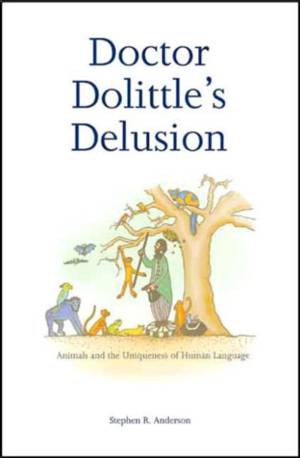
- Afhalen na 1 uur in een winkel met voorraad
- Gratis thuislevering in België vanaf € 30
- Ruim aanbod met 7 miljoen producten
- Afhalen na 1 uur in een winkel met voorraad
- Gratis thuislevering in België vanaf € 30
- Ruim aanbod met 7 miljoen producten
Zoeken
Doctor Dolittle's Delusion
Animals and the Uniqueness of Human Language
Stephen R Anderson
Paperback | Engels
€ 94,95
+ 189 punten
Omschrijving
Dr. Dolittle--and many students of animal communication--are wrong: animals cannot use language. This fascinating book explains why. Can animals be taught a human language and use it to communicate? Or is human language unique to human beings, just as many complex behaviors of other species are uniquely theirs? This engrossing book explores communication and cognition in animals and humans from a linguistic point of view and asserts that animals are not capable of acquiring or using human language.
Stephen R. Anderson explains what is meant by communication, the difference between communication and language, and the essential characteristics of language. Next he examines a variety of animal communication systems, including bee dances, frog vocalizations, bird songs, and alarm calls and other vocal, gestural, and olfactory communication among primates. Anderson then compares these to human language, including signed languages used by the deaf. Arguing that attempts to teach human languages or their equivalents to the great apes have not succeeded in demonstrating linguistic abilities in nonhuman species, he concludes that animal communication systems--intriguing and varied though they may be--do not include all the essential properties of human language. Animals can communicate, but they can't talk.
Stephen R. Anderson explains what is meant by communication, the difference between communication and language, and the essential characteristics of language. Next he examines a variety of animal communication systems, including bee dances, frog vocalizations, bird songs, and alarm calls and other vocal, gestural, and olfactory communication among primates. Anderson then compares these to human language, including signed languages used by the deaf. Arguing that attempts to teach human languages or their equivalents to the great apes have not succeeded in demonstrating linguistic abilities in nonhuman species, he concludes that animal communication systems--intriguing and varied though they may be--do not include all the essential properties of human language. Animals can communicate, but they can't talk.
Specificaties
Betrokkenen
- Auteur(s):
- Uitgeverij:
Inhoud
- Aantal bladzijden:
- 368
- Taal:
- Engels
Eigenschappen
- Productcode (EAN):
- 9780300115253
- Verschijningsdatum:
- 1/05/2006
- Uitvoering:
- Paperback
- Formaat:
- Trade paperback (VS)
- Afmetingen:
- 154 mm x 227 mm
- Gewicht:
- 485 g

Alleen bij Standaard Boekhandel
+ 189 punten op je klantenkaart van Standaard Boekhandel
Beoordelingen
We publiceren alleen reviews die voldoen aan de voorwaarden voor reviews. Bekijk onze voorwaarden voor reviews.











